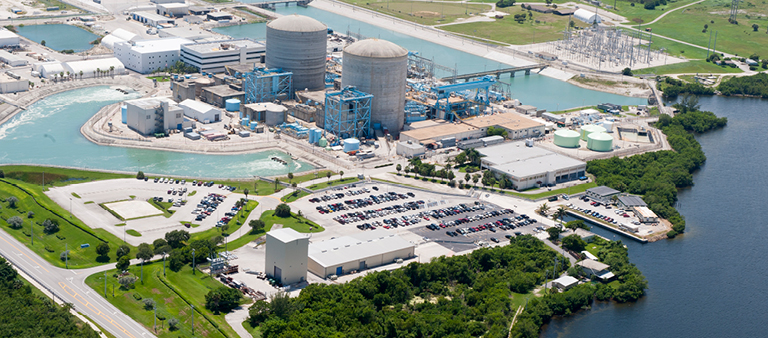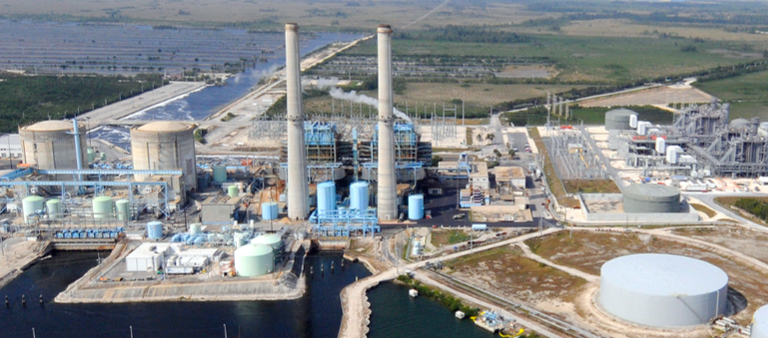Florida's Nuclear Plants Power Through Hurricane Irma

Florida Power and Light's St. Lucie nuclear plant; photo courtesy FPL
Hurricane Irma shocked the country this week with images of wind and water that haven't been seen in some time along the hurricane-wary coastlines of the United States. Although people in those regions always have preparation for these storms somewhere in their minds, the two Florida Power & Light (FPL) nuclear plants-both of which powered through the hurricane-had both a background of design and preparedness to stand on as well as some recent, last-minute preparations.
Robust Design, Made Readier
According to Florida Power & Light, both of its nuclear plants (two units at St. Lucie, and two units at the Turkey Point power station) have been constructed 20 feet above sea level, in order to protect them against the dual threats of floods and storm surges. The plants have been designed for the rugged environment sometimes occurring along the hurricane coast and, according to FPL, the two plants "have been specifically built to withstand natural disasters such as hurricanes, tornadoes, earthquakes, and tidal surges."
Both of these plants have multiple, redundant, large diesel generators in protected buildings-any one of which can provide enough power to protect the reactors (by maintaining cooling) after they're shut down. However, because of the more recent push to add what's called FLEX equipment to support the plant from outside the plant itself, extra emergency equipment is located on both nuclear plant sites. According to FPL, water injection and fire pump vehicles are on both sites, ready for deployment-and operators must periodically prove their ability to connect and operate this equipment. In fact, these two sites can operate safely by cooling the reactors for seven full days without the need for any electric power from off site, or the need to bring in any additional diesel fuel.
A Tough History
"Turkey Point successfully withstood the impact of Category 5 Hurricane Andrew in 1992," FPL said in its backgrounder on the plant-and added on its website "with no damage to its nuclear systems." The U.S. Nuclear Regulatory Commission noted recently on its blog, "Twenty-five years ago, Turkey Point was directly in the path of Hurricane Andrew, a Category 5 storm, and although many of the plant's structures were damaged and offsite power lines were lost, important safety equipment was safely maintained." Not that St. Lucie has been ignored either-it hasn't. According to FPL's site, "FPL's St. Lucie nuclear power plant safely withstood Category 3 Hurricane Jeanne and Category 2 Hurricane Frances in rapid succession in 2004 with no damage to its nuclear systems."

FPL's Turkey Point power station. The two nuclear units, which are Units 3 and 4, are at the left of this picture. Photo courtesy FPL.
Inaccurate Reporting Leads to Unrealistic Fear
The preparations above-the construction of the plants high, the protection against flooding, the provision of multiple emergency diesel generator backups as well as the onsite portable equipment that can inject cooling water, even using seawater-were further bolstered by rigorous, if rapid, preparation at the two nuclear plant sites, both assisted by and reported by the NRC.
On September 8, before the massive hurricane began to impact Florida, the NRC reported the following on its blog:
"Florida Power & Light, the company that operates Turkey Point and St. Lucie, is working through a very detailed storm preparation procedure. That work includes checking equipment and supplies such as diesel generator fuel, securing or moving other equipment or items that might be blown around, and implementing a staffing plan to ensure enough operators and support staff are on site around the clock if roads become inaccessible.
Meanwhile, the NRC's resident inspectors at the two sites are watching and ensuring company employees are following their procedures. The NRC's Region II office in Atlanta has already dispatched two additional inspectors to Turkey Point and two others to St. Lucie so the resident inspectors assigned to those sites can take care of their homes and families.
As Hurricane Irma moves closer, the NRC will activate its Incident Response Center in Atlanta for around the clock staffing and begin ongoing communications with the plants and the NRC inspectors on site."
The NRC also issued a press release just as the hurricane began to exert its forces on the Turkey Point plant. In part, the NRC wrote:
"In preparing for Hurricane Irma, the staff at Turkey Point, St. Lucie, and other plants in the
Southeast are working through severe weather procedures, including ensuring that all loose debris and equipment has been removed or secured and conducting walk-downs of important systems and equipment.
The NRC is satisfied that these actions will adequately protect the public during this hurricane. NRC inspectors are verifying that all of the preparations have been completed, and the plants' emergency diesel generators are available to be used if the storm affects off-site power supplies."
Allegations made in a recent Newsweek magazine article that the plants did not meet what were called "federal safety guidelines" are clearly demonstrably false-the evidence is above, issued by the NRC itself. It should be noted that any fears surrounding the safe operation of these plants derived from such reporting are wholly unfounded.
Plants Undamaged by Storm but Some Idled
As the hurricane warning was extended to the area of Turkey Point, the decision was made by FPL management to commence a shutdown. However, as described by FPL in a live video update presented on its site and on Facebook, only Unit 3 had progressed far enough into the shutdown procedure to actually secure operations when a re-estimation of winds showed that the plant would not encounter hurricane force winds. Thus, Unit 4 remained in operation to provide power to the grid. (Turkey Point has a number of power units, and only Units 3 and 4 are nuclear.) St. Lucie, on the other hand, never approached shutting down either unit based solely on wind estimates.
On the evening of September 10, just before 7 p.m. Eastern time, Turkey Point-4 had to shut down because of an equipment failure unrelated to the storm. A feed regulating valve (which controls the flow of water into one of the plant's three identical steam generators) failed, and the operators noted a lowering water level in the associated steam generator and tripped the reactor. The shutdown process was normal, and the plant is still shut down safely as this is written on September 12.
As far as St. Lucie was concerned, the plant remained on line despite a flurry of nearby but not direct tornado warnings-most of which were generated by Doppler radar signatures noted in the swirling storms on the northeast quadrant of Irma. (This reporter is also a trained SKYWARN storm spotter and was monitoring the tornado situation near the plant, remotely.) However, Unit 1 later had to first reduce power and then shut down on September 11, as reported by the NRC on its blog,
"At St. Lucie, also in Florida, operators are reducing power on Unit 1 due to salt buildup on insulators in the switchyard that supplies offsite power and plant employees are working to resolve this situation."
It is important to point out that none of these events had any effect-real, potential, or otherwise-on public safety. In the case of Turkey Point-4, we might liken the feed regulating valve failure to a flat tire or broken fan belt on a car-an unfortunate nuisance, poorly timed, but completely unrelated to the weather. This can happen at any time, and there are procedures to follow when it does-which the operators did. St. Lucie-1's shutdown was apparently related to salt spray from the sea being whipped angrily by Irma, but the plant was never in any danger from this buildup and was shut down before an any more complicated situation might have developed, although, again, the plant has multiple redundant electric power sources. It's important to note that the immediately adjacent St. Lucie-2 (also nuclear) remains at full power as this is written, so the effect of the salt spray only affected Unit 1's switchyard connection to offsite power.
Information Removes Fear
In the final analysis, it's safe to say that in the last two weeks some of the U.S.'s nuclear plants (including the South Texas Project during Hurricane Harvey) have weathered severe meteorological tests and come up with very high marks. And these plants aren't all-the NRC, ever vigilant, has assessed the maximum potential impact from Irma (as it did Harvey) and wrote the following on the September 11:
"As of Monday morning, the Region II Incident Response Center staff is monitoring potential effects from the storm on the Hatch nuclear plant in south Georgia and the Farley nuclear plant in south Alabama. The two units at Hatch and the two units at Farley are currently at full power. Even though the staffs at both sites have completed storm preparations, it appears that projected winds will not be strong enough to affect plant operations at these two locations."
FP&L and the NRC ensured the public that the plants were safe, that preparations were made, and that procedures were followed in getting ready for the storm. As we've seen, the plants are not only robust and well backed up by added onsite mobile equipment, they're weather tested, and diligently and continuously monitored (and reported on) by the NRC. We can, and should, expect the same kind of performance at nuclear plants anywhere else hurricanes threaten the United States. Judging by this week's performance, there will be precious little to report on then as well.

